GERMAN REUNIFICATION | 27.09.2010
Reunified Germany is a nation of many faces and variable success
One important measure of today's undivided Germany is economic, and on this score, as on so many others, the picture is mixed.
Huge strides have been made in the past twenty years. Just about every eastern German city and town has been thoroughly renovated. And while income and other economic indices in the East are only 70 to 80 percent of what they are in the West, costs of living - especially for rent - are commensurately lower, so one could argue most eastern Germans aren't that much worse off than their Western fellow citizens.
"Silicon Saxony" with its computer chips, and the optical industry in and around the city of Jena in Thuringia, are two examples of eastern industrial success.
"I'm very impressed with how the people in Germany's new states mastered the considerable challenges after 1989," German Finance Minister Wolfgang Schaeuble, who helped negotiate the original Unification Treaty, told Deutsche Welle. "I'm not disappointed at all."
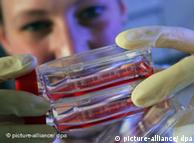 Some high-tech industries have flourished in the East
Some high-tech industries have flourished in the East
But not everyone's a winner. As of July 2010, unemployment in the east (11.5%) was nearly double what it was in the West (6.6%), and an astonishing 50 percent of the 80 billion euros ($103 billion) in annual developmental subsidies transferred from west to east is eaten up by social benefits and welfare payments.
"Unfortunately, economic processes don't work along the lines of what is just," Richard Schroeder - a respected former professor of philosophy and theology at Berlin's Humboldt University - said at a major conference earlier this year. "We have large numbers of people who weren't pillars of the old system but whose situations have gotten a lot worse after the economic caesura."
Some 1.6 million people have relocated from east to west since 1990, most in search of better job opportunities, and that trend shows no sign of letting up. Moreover, sociologists speak of a "brain drain" from the East since it's the better educated who make up the majority of those who leave.
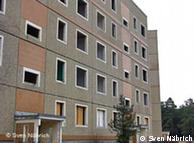 Empty apartment blocks are a common sight in Hoyerswerda
Empty apartment blocks are a common sight in Hoyerswerda
It's not uncommon to see unneeded housing units being torn down in eastern cities. The most extreme example is Hoyerswerda near Germany's border with Poland and the Czech Republic, which has lost half of its population in the past decade.
In these respects, two different economic subsets continue to exist. And dissatisfaction with such differences and inequities has manifested itself politically.
The rise and fragmentation of the Left
The incorporation of what Germans call the "new states" into the political system of the Federal Republic has wrought changes few would have anticipated back in 1990.
The current German chancellor, Angela Merkel, hails from the East, although many Germans tend to forget that fact. And though most eastern Germans vote for one of the western parties, others have sought their own alternative.
The Left Party, the successor to the old socialist party in Communist East Germany, combined with left-wing fringe parties from the West, has established itself as a mouthpiece for disgruntled easterners.
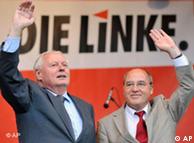 Gysi (right) and westerner Oskar Lafontaine led the Left Party to prominence
Gysi (right) and westerner Oskar Lafontaine led the Left Party to prominence
"Reunification had a structural flaw in that the elites of the East weren't accepted, and not just the political elites, but the pedagogical, scientific and artistic elites as well," Left Party parliamentary leader Gregor Gysi told Deutsche Welle. "In the beginning, they had no time for my party, but they were rebuffed and forced back to us because the other parties weren't prepared to accept them."
The ironic result is that while the SPD and the Greens are leery of cooperating with former communists, the political left is bifurcated, helping Merkel's center-right government to hold on to power.
The establishment of the Left Party as a form of peaceful political protest can be seen as evidence of eastern Germans' adoption of western democracy. But it has also deepened many western Germans' sense of a cultural divide between them and their fellow citizens.
Ost- and Westalgia
One unambiguously positive aspect of reunification has been the removal of political barriers that kept many German families painfully separated during the Cold War. There are no exact figures for how many West and East Germans had relatives in the "other" Germany, but an average of 26 million care packages were sent annually from west to east during Germany's division - an indication of the personal hardships caused by political division.
"Those who felt imprisoned were overjoyed at an end to their suffering," says Brigitte Klump, an author whose private petitions to the United Nations over the course of many years helped some 4,000 people leave Communist East Germany. "And naturally I still feel joy when I hear from people who succeeded in integrating into the West."
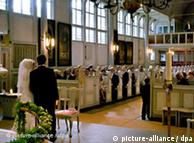 There aren't many East-West marriages
There aren't many East-West marriages
Ostalgia - eastern Germans' supposed longing for the way things were - is a regular topic in the media, but in polls only around ten percent of easterners say they preferred life under socialism. And eastern Germans' self-identification as a group decreases the later they were born.
Meanwhile, around half of western Germans say the time before 1989 was better than afterward. This reflects their fond memories of a period of affluence and clear social consensus and suggests that "westalgia" is far more prevalent than its eastern equivalent.
Partnerships between eastern and western Germans make up only around four percent of all German marriages. This may be due to the fact that most Germans still stay in the places they grew up and maintain long-term social circles. But the number of "Ossis" and "Wessis" tying the knot lags significantly behind that of Germans and foreigners.
"Thanks to reunification, Germany as a whole has gotten a lot more diverse, and feelings of togetherness have grown," Wolfgang Schaeuble said. "What we still need is time, patience, including patience with one another, and the experience of having successfully solved problems together."
The global factor
One oft-neglected aspect of reunification is the contributions made by residents who do not hold German passports and the effects it had on them.
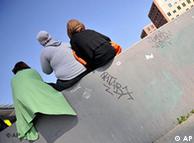 Foreigners are also part of the story
Foreigners are also part of the story
Foreigners account for roughly eight percent of Germany's population, and with the removal of the East-West political divide, German society became much more multicultural, with large communities from Eastern Europe joining the substantial Turkish minority that had established itself in the post-war Federal Republic.
"The German immigrant nation is one of many nationalities, including Germans from the old Federal Republic, others from the former East, millions of ethnic Germans from Eastern Europe as well as an immigrant population of non-German descent," said Germany's leading immigration expert Klaus Bade. "Former 'guest workers' make up the majority, but there are also lots of smaller groups from an ever greater variety of backgrounds."
Foreigners have an inestimable impact on today's German society, and immigration is crucial in offsetting population decline, as both western and eastern Germans are having fewer and fewer children.
But after a boom immediately following the end of the Cold War, the number of foreigners in Germany has stagnated. Economists and sociologists see this as a worrisome trend because Germany needs to increase its workforce to compensate for the aging population entering retirement.
Two decades on from 1990, it is more apparent than ever that "reunification" is not a restoration of a past society, but a process of creating something new that is inextricable from globalization. Old national paradigms are coming under ever increasing challenges, so the future of the new Federal Republic is likely to be influenced just as much by factors from abroad as from within its own borders.
Author: Jefferson Chase
Editor: Kristin Zeier
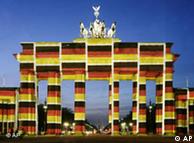

No comments:
Post a Comment